Hello, there. Did you see the large number of images from December 2003? Weren’t those last 10 days of the month grand?
Anyway, with me back at work early in January 2004, here is a much smaller offering of images, from that month. Why are there much, much fewer pictures from January 2004 compared to the month that preceded it? Well, the reason for the huge amount of pictures in late December is explained in that piece linked in the prior paragraph!
Sunday, The 11th
There was this neat place just east of the east siding switch of Schriever, where the Napoleonville Branch began in Lafourche Parish, where one could publicly see trains, but it ended in 2005 when the parish ceded control of the road to local farmers, which really depressed me. This place was known as Thibodaux Junction, at milepost 54 of the Sunset Route, because it was the beginning of the branch that originally went only to Thibodaux; the place in Thibodaux where the next branch began was known as Napoleonville Junction, which is right where Jackson Street meets Canal Boulevard in Thibodaux today.
On this Sunday morning at 10:32 CST, The Mathews Foamer and I were at Thibodaux Junction where we saw a short westbound Union Pacific Railroad intermodal train led by a CSX SD40-2 and a CSX Dash-8. It had CSX Intermodal containers, meaning it was probably an IATCI, but there were no Tropicana cars.
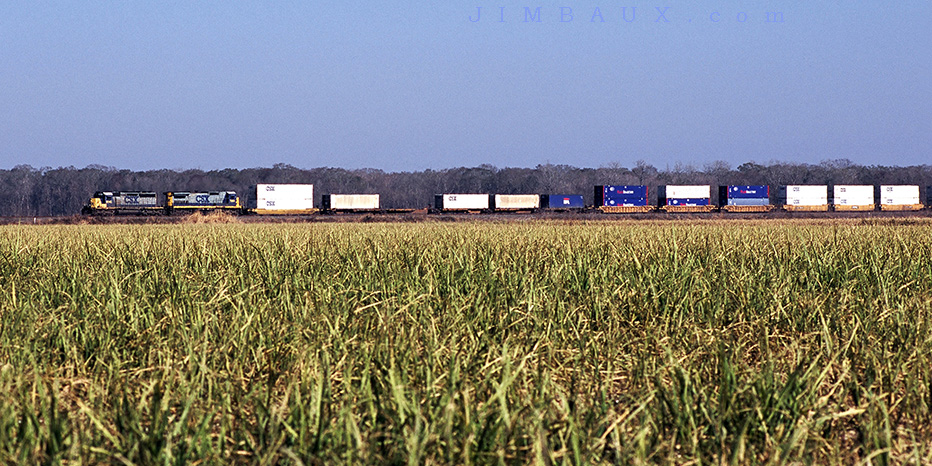
The IATCI was an intermodal train (the “I”) that ran from Atlanta, Georgia, (the “AT”) to City Of Industry, California, (the “CI”) once it became a UP train in New Orleans.
Five years to the day later, I made some staged images of a fake Kansas City Southern Railway train on the riverfront next to the French Quarter in New Orleans.
Tuesday, The 13th
I think that this picture was taken on the Richard property up the bayou from Raceland (there are actually several Richard properties up the bayou from Raceland), but I am really not sure.
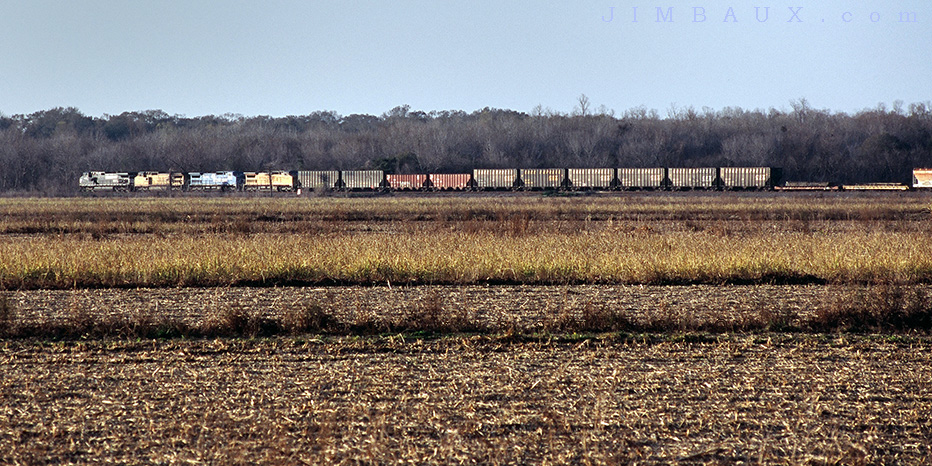
Around 16:30, this westbound UP manifest pulled into the siding at Schriever to await the arrival of a “BNSF 4638 west”. This train had the following quartet of mixed-up GE locomotives: NS 9075, UP 9435, PRR 8324 (blue), UP 9530.
It had 408 axles and was the MNOHO-12 – Manifest, New Orleans to Houston of the 12th. There were several CSX “Coke Express” hoppers on the front, and there were some Golden Triangle Railroad boxcars not much farther back. The train got a track warrant to Bayou Sale.
Wednesday, The 14th
It’s another day with another MNOHO, this one being a little bit less cool than the previous day’s MNOHO. Here we are at Kraemer Road east of Raceland at around 16:25.
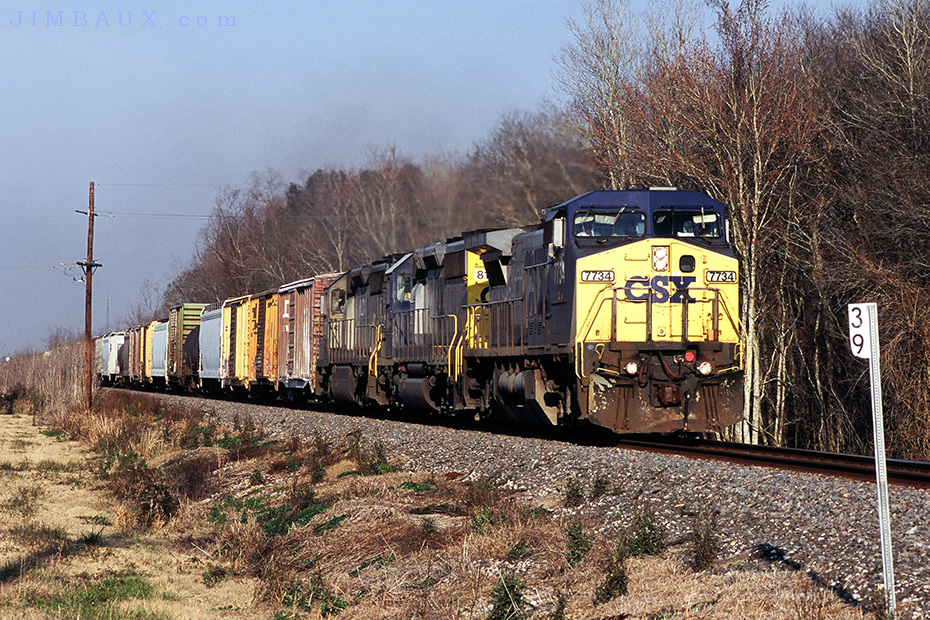
The train had 512 axles and, as was typical for MNOHOs, had many boxcars and railroad-owned hopper cars.
Sunday, The 18th
It’s a Sunday morning, and it’s time for my Sunday Sermon, and, in this section, I describe the transition happening in what was one of the best photo locations close to my home, and one that got taken away in 2005 when the public road that had made it possible became a private road.
This was a late Sunday Sermon, as I arrived on the scene at Schriever at 11:30 CST, and there was a westbound UP train sitting on the mainline. It had three locomotives.
UP 9046 – C40-8 – very filthy
UP 4140 – SD70M
UP 9784 – patched C&NW GE
It looked like a M-NOEW until I spied some auto racks near the end of the train. Auto racks are extremely rare on the Lafayette Sub. At that time, the only times that I had seen them on UP trains was in the MNOHO, but this train didn’t look like an MNOHO. According to Blaze, this train was the MNOEW-17. The four auto racks were loads from Florida going to Texas Hobby Auto Auction in Pearland, Texas, via the BNSF at Houston.
At 11:45, an eastbound BNSF Railway intermodal train pulled into the siding. I had been thinking about heading to Chacahoula to shoot a broadside of the MNOEW-17, but I changed my mind when I saw the power consist of this eastbound train.
BNSF 4934 – C44-9W – H2
BNSF 345 – GP60B – H1
I decided to let the westbound train go, since the leader was filthy anyway, and head east to try a new broadside shot at Thibodaux Junction, milepost MP 54. It was a new shot because some trees along the right of way had recently been removed. I squatted down low enough to where the rails were on the horizon, meaning no treetops meeting the top of the train, and I photographed it pulling out of the siding at the junction at 12:00.
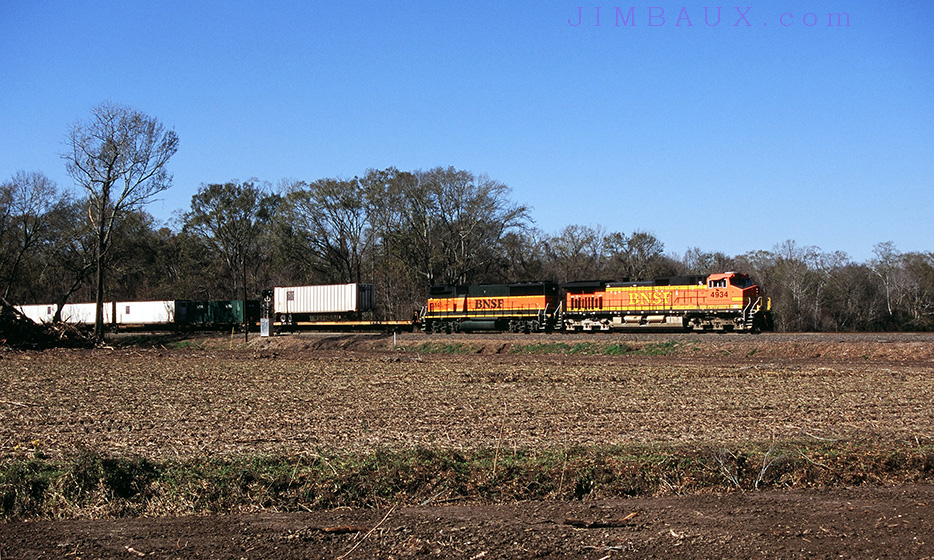
An A/B lashup was so rare even then, and it became even more rare after that; so, I wanted to take advantage of it.
Thibodaux Junction was, only briefly, a great place to photograph trains. It is – or was – called Thibodaux Junction because it is where the branch to Thibodaux, from which there soon was another branch to Napoleonville (to the point that, eventually, SP called the whole thing “the Napoleonville Branch”), diverged from the mainline, but the branch actually diverged from the siding; however, there was once a wye there, the western leg of which was the beginning of the branch, with the eastern leg long gone.
A few years prior to these pictures being made, the Acadia Road crossing was surrounded by trees. The subsequent – and, when this picture was made, ongoing – clearing of the trees really opened up some great picture possibilities, and I took advantage of these opportunities in the early aughts.
However, it seems the reason for the clearing of trees was also or, at least, was related to the reason that, a little bit more than a year later, I would no longer be able to access this area at all. Local farmers were expanding the fields. The land where the trees were is now sugarcane fields, and Lafourche Parish eventually ceded Acadia Road to the farmers in that area, to my great despair, ending access to what was one of the greatest photo locations for trains for many around.
One reason that this was such a great area for photographing trains is that it was a good shot from either side of the track; that is rare, because, usually, an automobile-road crossing that is a good photo location is a good photo location from only one side of the track. The first picture in this essay is from the southern side of the track looking to the east of a westbound train, while, later in the year, the same road north of the track would become a good late-afternoon location for westbound train pictures, as I did a few months later.
On this day, I am photographing an eastbound train here, a new shot made possible by additional recent tree clearing.
This train got a track warrant to Raceland, where he was to meet another westbound train, this time a BNSF Railway train. The defect detector at milepost 49.6 indicated a train of 146 axles. The dispatcher told the train to put his train in a certain track at Avondale and take the locomotives light across the river to the New Orleans Public Belt Railroad, which serviced BNSF locomotives at that time. I had the impression that the crew would deadhead back to Lafayette.
I then returned to Schriever to await the second westbound train. When he stopped to align the east siding switch (milepost 54.1), I proceeded to Chacahoula (milepost 61.4) to get a broadside shot of him, not knowing anything more than the lead unit being a Heritage 2 GE Dash 9. I wished I had stayed at Schriever, because this manifest train had five locomotives, and the broadside shot at Chacahoula was too narrow to show more than locomotives for a train with that many locomotives: BNSF 4458, two Green SD40-2s (one of them a lease unit), a UP 6000-series GE, and an NS Horsehead unibrow Dash-9.
The train had 478 axles, and it looked like a H-NWOBAR, but I really don’t know. I had commented earlier that I usually see this train in the mornings, and the same occurred today except it being a few hours later.
The dispatcher mentioned that Lafayette was turning more eastbound trains loose and would need to change some track warrants for westbound trains because of this.
Also, there was what appeared to be a large transformer-looking thing on a depressed-center flat car set out at the east end of the storage track, but I couldn’t get close enough to get more details.
All in all, it was a glorious Sunday trackside.
The 19th . . . Or The 22nd ?
I am pretty sure that these pictures, these last two pictures in this photo essay, were taken on the afternoon of the 19th, but I do not think that this is certain. My old notes indicate that I photographed the same train at around the same time of day three days later on the 22nd, but the evidence that these were made on the 19th is stronger; so, let’s go with that.
It’s solid scarlet-and-grey on the LLS51! Here is UP train LLS51 with two unpatched SP/SSW locomotives! The Southern Pacific is not quite dead yet.
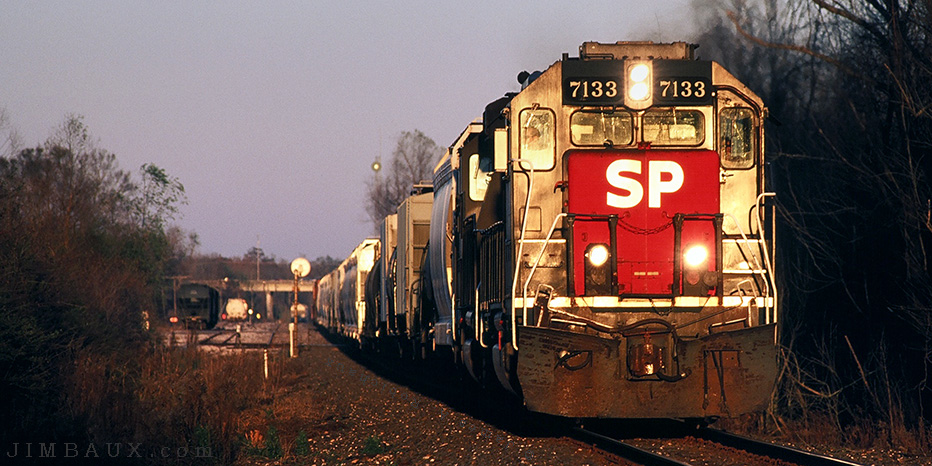
The first locomotive was SP 7133, and the second locomotive was SSW 9656. That is plenty of Monsanto runaround traffic that the train is carrying.

Part of the problem with the confusion from my notes here is that one version of the notes says that these pictures were made at 15:09, and I know that, at that time of the year, the sunlight at that time has yet to swing around to the northern side of the track; the notes from the train that I photographed three days later at this same location say that those pictures were made at 16:40, but the original slide from which these two image were scanned said that the images were made at 17:07, which seems right and which leads me to think that I typed “15:09” meaning “5:09 pm”.
Anyway, my digital notes from the Thursday version of this train says that “the sounds made by the horns were really nice and soft”; since the same power set worked this train on both of these days, we can assume that that horn effect accompanied the pictures that you see here, too.
That’s all for now.
Close Up
The week after these images were made, I went on a journey to the nation’s capital that really changed my life, had a profound impact on me. It had a dramatic impact on my thinking and behavior, and it’s a big reason that I decided to spend that summer in Mexico and that the marathon of spending almost the entire two-week Christmas-New-Years break chasing trains like I did in 2003 was not really repeated in 2004, for I felt that doing so would have been a waste of time and my talent that I needed to put to higher pursuits.
That’s all. Thanks for reading this.
Jim
